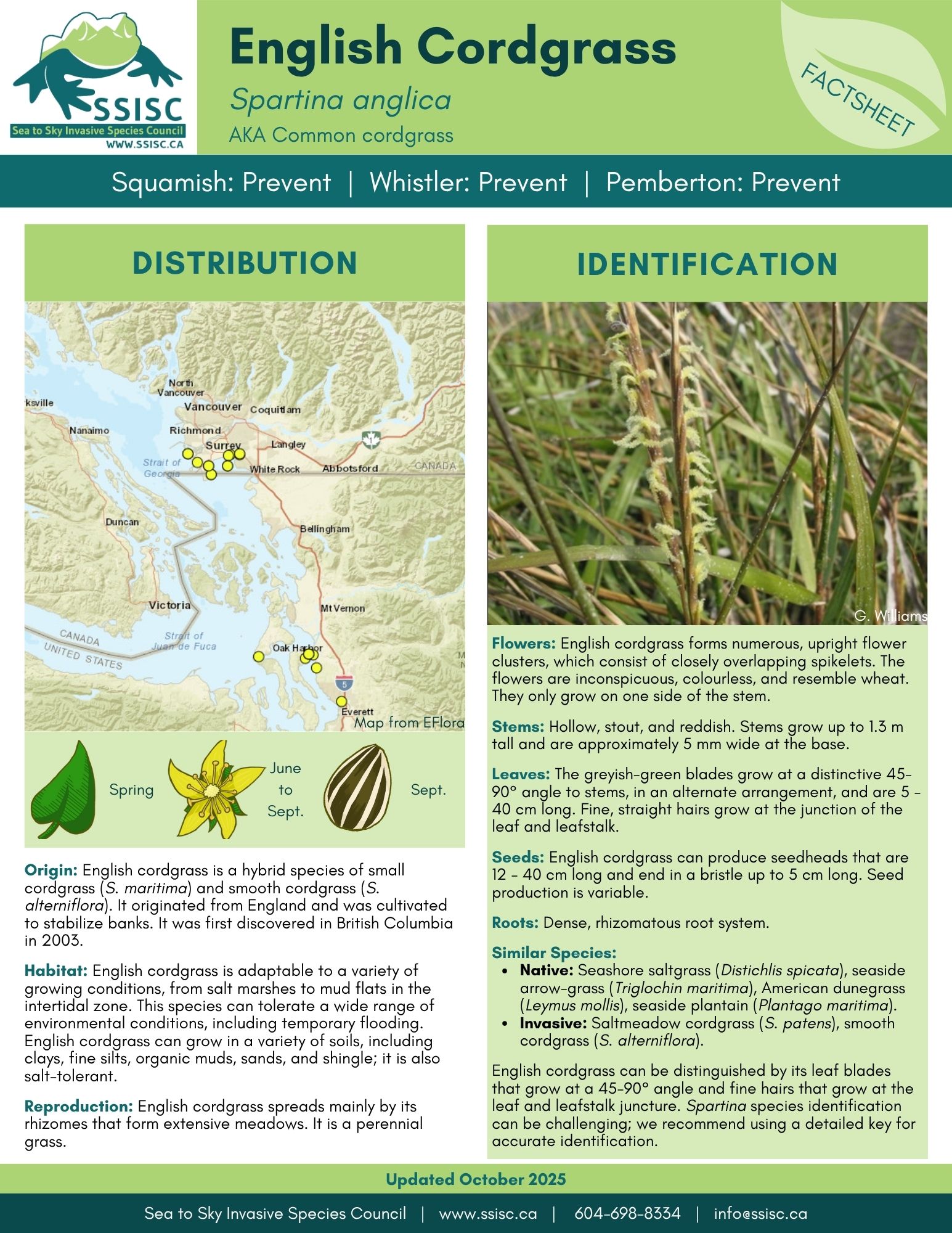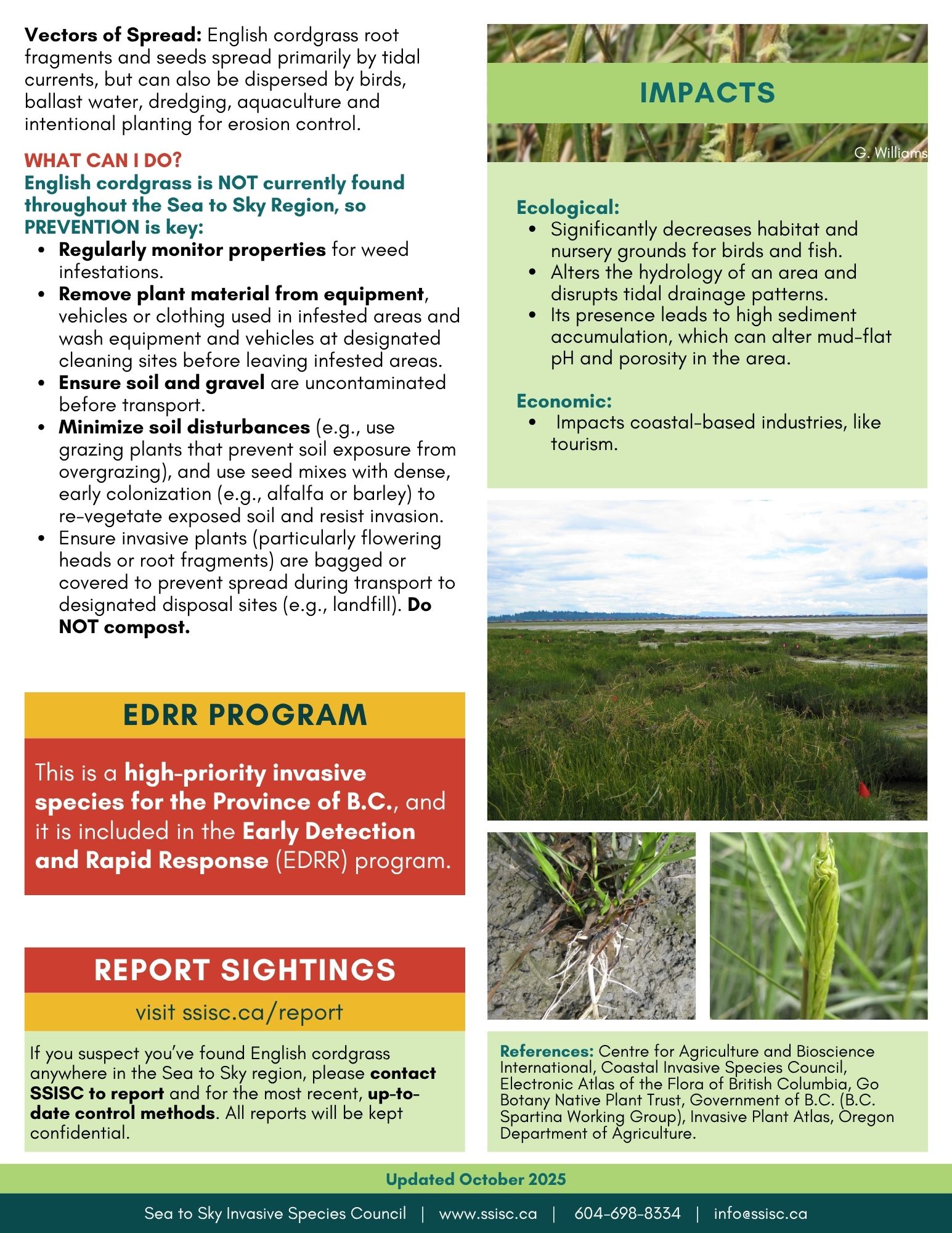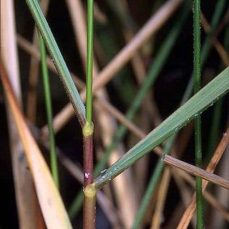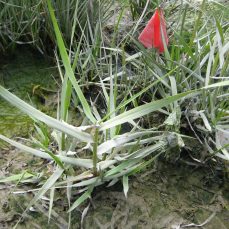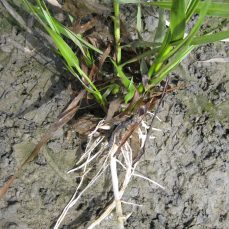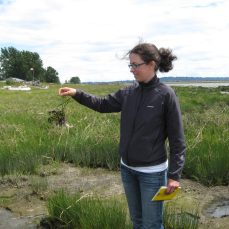English Cordgrass (Spartina anglica)

Photo credit: Garry Williams
Synonyms
English cordgrass is also known as common cordgrass.
ID Characteristics
General: English cordgrass is a perennial grass from the Poaeceae family.
Flowers: English cordgrass forms numerous, upright flower clusters, which consist of closely overlapping spikelets. The flowers are inconspicuous, colourless, and resemble wheat. They only grow on one side of the stem.
Stems: Hollow, stout, and reddish. Stems grow up to 1.3 m tall and are approximately 5 mm wide at the base.
Leaves: The greyish-green blades grow at a distinctive 45-90° angle to stems, in an alternate arrangement, and are 5 – 40 cm long. Fine, straight hairs grow at the junction of the leaf and leafstalk.
Seeds: English cordgrass can produce seedheads that are 12 – 40 cm long and end in a bristle up to 5 cm long. Seed production is variable.
Roots: Dense, rhizomatous root system.
Similar Species
Overall, English cordgrass can be distinguished by its leaf blades that grow at a 45 to 90-degree angle and fine hairs that grow at the juncture of the leaf and the leafstalk.
Invasive
- Saltmeadow cordgrass (Spartina patens)
- Smooth cordgrass (Spartina alterniflora)
- Dense-Flowered cordgrass (Spartina densiflora)
English cordgrass can be extremely challenging to distinguish from other grass species. Accordingly, we recommend the use of a detailed key for positive identification (please refer to the references section for more links).
Native
- Seaside arrow-grass (Triglochin maritima) has small purple flowers that are clustered along the length of the flowering stem.

Photo credits: Rob Routledge, Sault College, Bugwood.org
- American dunegrass (Leymus mollis, L. arenarius) has thick rhizomes (fleshy roots) and its leaves are slightly hairy on top. Its flowers are also a greenish yellow tone, rather than a reddish one for English cordgrass

Photo credit: Nisa Karimi, Wisconsin Department of Natural Resources, Bugwood.org
- Seashore saltgrass (Distichlis spicata) has rhizomes (fleshy roots) and is shorter (10 – 40 cm).
- Seaside plantain (Plantago maritima) is shorter (up to 25 cm tall).
Habitat and Origin
English cordgrass is a hybrid species of small cordgrass (S. maritima) and smooth cordgrass (S. alterniflora). It originated from England and was cultivated to stabilize banks. It was first discovered in British Columbia in 2003.
English cordgrass is adaptable to a variety of growing conditions, from salt marshes to mud flats in the intertidal zone. This species can tolerate a wide range of environmental conditions, including temporary flooding. English cordgrass can grow in a variety of soils, including clays, fine silts, organic muds, sands, and shingle; it is also salt-tolerant.
How it Spreads
English cordgrass spreads mainly by its rhizomes that form extensive meadows. It is a perennial grass.
English cordgrass root fragments and seeds spread primarily by tidal currents, but can also be dispersed by birds, ballast water, dredging, aquaculture and intentional planting for erosion control.
Impacts
Ecological:
- Significantly decreases habitat and nursery grounds for birds and fish.
- Alters the hydrology of an area and disrupts tidal drainage patterns.
- Its presence leads to high sediment accumulation, which can alter mud-flat pH and porosity in the area.
Economic:
- Impacts coastal-based industries, such as tourism.
Stop the Spread
English cordgrass is NOT currently found in the Sea to Sky Corridor, so the best approach to controlling its spread is PREVENTION.
This is a high-priority invasive species for the Province of BC, and it is included in the Early Detection and Rapid Response (EDRR) program.
If you see English cordgrass, please report it.
Distribution of English Cordgrass in BC
English Cordgrass Factsheet
Having trouble viewing the factsheet? Don’t worry, all the information is included on this page. You can also contact us with any questions.
Additional Resources
References
- BC Spartina Working Group. Spartina
- Centre of Agriculture and Bioscience International
- Coastal Invasive Species Council
- Electronic Atlas of the Flora of British Columbia, Distichlis spicata
- Electronic Atlas of the Flora of British Columbia, Leymus mollis
- Electronic Atlas of the Flora of British Columbia, Plantago maritima
- Electronic Atlas of the Flora of British Columbia, Spartina anglica
- Electronic Atlas of the Flora of British Columbia, Spartina patens
- Go Botany Native Plant Trust, Spartina
- Government of BC, Cordgrasses (Spartina anglica, S. densiflora, S. patens) Frequently Asked Questions
- Invasive Plant Atlas, Common Cordgrass
- Oregon Department of Agriculture, Key to West Coast Spartina Species Based on Vegetative Characteristics
- San Francisco Estuary Invasive Spartina Project, Spartina anglica, https://spartina.org/species/spartina-anglica_v2.pdf



